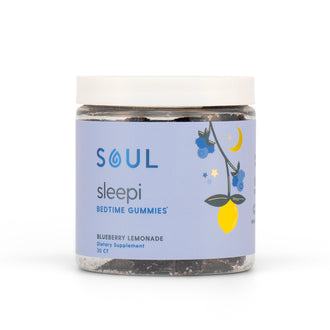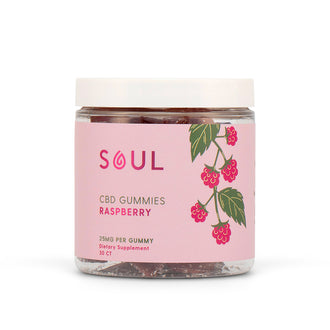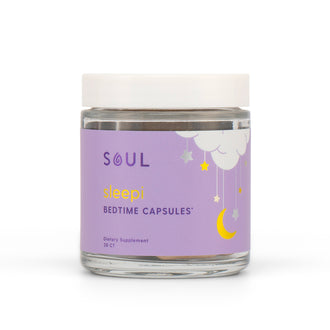
Key Takeaways:
- Precise Dosing is Essential: Accurately measuring THC oil and understanding potency are crucial for creating safe and enjoyable edibles.
- Patience is Key with Edibles: Edibles take time to produce effects, so always start with a low dose and wait at least 1–2 hours before consuming more.
- Proper Storage Ensures Safety and Freshness: Store THC edibles in labeled, airtight containers, away from light, heat, and out of reach of children or pets to maintain quality and safety.
Making edibles with THC oil is a fantastic way to enjoy cannabis. Whether you’re a seasoned cannabis enthusiast or a curious beginner, edibles provide a longer-lasting and often more intense experience compared to smoking or vaping.
At Soul, we’ve dedicated ourselves to harnessing the power of THC for wellness. With our expertise and premium-quality THC products, we’re here to guide you through this process—step by step—so you can create edibles that are enjoyable, reliable, and tailored to your needs.
This guide will walk you through everything you need to know—from the basics of THC oil and necessary tools to a step-by-step process for creating your own edibles.
What You’ll Need To Get Started
Before you begin making edibles with THC oil, it’s important to gather all the necessary tools and ingredients. Having everything ready ensures a smooth process and helps you focus on creating high-quality edibles. Here’s what you’ll need:
Tools
- Mixing Bowls: For combining ingredients.
- Measuring Cups and Spoons: To ensure precise measurements.
- Cooking Utensils: Such as spatulas and whisks for mixing.
- Baking Pans or Molds: Depending on the type of edible you’re making (e.g., brownies, gummies).
- Stove or Oven: For heating and baking.
- Digital Scale (Optional): To accurately measure THC oil and other ingredients for proper dosing.
Ingredients
- THC Oil: The star ingredient. Make sure it’s properly decarboxylated and lab-tested for potency.
- Basic Ingredients for Your Recipe: For example, flour, sugar, butter, eggs, or gelatin—depending on the edible.
- Flavorings or Add-ins: Such as vanilla extract, chocolate chips, or fruit for extra taste.
Optional
- Gloves: To handle THC oil and avoid direct contact.
- Silicone Spatula: For scraping every last bit of the mixture, especially when dealing with sticky THC oil.
Understanding THC Oil And Its Effects
THC oil is typically made by extracting cannabinoids from the cannabis plant, resulting in a potent liquid. When consumed, THC is metabolized by the liver, converting it into 11-hydroxy-THC, which is more potent and has a longer-lasting effect. This is why edibles tend to produce stronger and longer-lasting effects compared to smoking or vaping. However, the effects may take 30 minutes to 2 hours to kick in, so patience is key when consuming edibles.
Step-by-Step Guide To Making Edibles With THC Oil
Now that you’re familiar with THC oil and have your tools and ingredients ready, it’s time to start making your edibles.
Step 1: Choose Your Recipe
Decide what type of edible you’d like to make. Brownies, cookies, gummies, or even salad dressings are great options. Select a recipe that’s simple to follow and can incorporate THC oil without compromising flavor or texture.
Step 2: Measure The THC Oil
Accurate dosing is key to creating enjoyable edibles. Use a measuring spoon or digital scale to determine the exact amount of THC oil needed for your desired potency.
Step 3: Mix Ingredients
Follow your chosen recipe, mixing the dry and wet ingredients as instructed. When it's time to add the oil, mix it thoroughly into the batter or dough to ensure even distribution. This step is crucial to avoid uneven potency across servings.
Step 4: Bake Or Cook
If your recipe requires baking, preheat the oven to the specified temperature. Be mindful not to use excessive heat, as temperatures above 320°F (160°C) can degrade THC, reducing the potency of your edibles. For stovetop recipes, cook on low to medium heat.
Step 5: Let It Cool And Portion
Once your edibles are cooked, allow them to cool before portioning. Use a knife or mold to divide the batch into individual servings. This helps ensure consistent dosing and makes storage easier.
Step 6: Label And Store
Clearly label your edibles to indicate they contain THC and store them in a safe place, out of reach of children and pets. Proper storage also preserves freshness and potency.
Dosage Tips And Calculations
Getting the dosage right is one of the most important aspects of making THC edibles. Proper calculations ensure a safe and enjoyable experience, avoiding overconsumption. Here’s how to manage dosage effectively:
Know The Potency Of Your THC Oil
Start by determining the concentration of THC in your oil, which is typically measured in milligrams per milliliter (mg/mL). This information is often provided on the product label. For example, if your THC oil contains 10 mg/mL and you use 5 mL, your recipe will contain 50 mg of THC total.
Decide On The Total THC Content
Consider how potent you want each serving to be. A typical starting dose for beginners is 2.5 to 5 mg of THC per serving, while more experienced users might prefer 10 to 20 mg. Multiply the desired dose by the number of servings to calculate the total THC needed in your recipe.
Adjust The Recipe
If your oil is too potent for your recipe, you can dilute it with a carrier oil like coconut or olive oil to achieve the desired concentration. Conversely, if your recipe requires more THC, ensure you distribute it evenly throughout the mixture for consistent potency.
Test And Adjust
Always start with a small dose when consuming homemade edibles. If the effect is milder than expected, you can increase the THC content slightly in your next batch. Be cautious, as overestimating can lead to discomfort.
Common Mistakes To Avoid
There are a few common mistakes that can affect the quality, potency, and safety of your creations:
Using Too Much THC Oil
Using excessive THC oil in your recipe can lead to edibles that are far too potent, resulting in discomfort or overwhelming effects for those consuming them. It’s crucial to calculate your desired dosage carefully based on the THC concentration of your oil and the number of servings. When in doubt, start with less THC oil and adjust future recipes once you know how the potency works for you.
Uneven Mixing
Failing to mix the THC oil thoroughly into your recipe can lead to uneven potency. Some servings might be much stronger than others. Take extra care during the mixing process to distribute the oil evenly.
Cooking At High Temperatures
High temperatures can degrade the THC in your oil, significantly reducing the potency of your edibles. Always keep your cooking or baking temperatures below 320°F (160°C) to preserve the cannabinoids. If your recipe requires higher temperatures, consider adding the THC oil after cooking, such as stirring it into frosting or drizzling it over a finished dish.
Ignoring Labeling And Storage
Failing to label your edibles can result in accidental consumption, especially in shared households or when gifting them to others. Always clearly indicate that the food contains THC and include an estimated dosage per serving. For storage, use airtight containers to maintain freshness and keep them in a cool, dark place to prevent THC degradation from light and heat.
Not Testing The Batch
Skipping the testing process can result in edibles that are too strong or too weak. Always try a small piece of your edible first and wait 1–2 hours before consuming more. This step helps you understand the potency and effects before sharing or eating more.
Underestimating Onset Time
The effects of edibles can take anywhere from 30 minutes to 2 hours to kick in. Some people mistakenly eat more during this waiting period, leading to an overwhelming experience. Patience is key with edibles.
Storing Your THC Edibles Safely
Store edibles in airtight containers, keep them cool and away from light, and label them clearly to prevent accidental consumption. Use refrigeration for perishables and freeze for long-term storage.
Use Airtight Containers
Airtight containers help lock out air and moisture, which can degrade the THC and cause your edibles to lose potency over time. They also prevent odors from escaping, which is particularly useful if you’re storing edibles in a shared space. Consider using food-safe materials like glass jars, resealable plastic bags, or silicone containers to ensure the edibles remain fresh and safe for consumption.
Keep Them Cool
Heat can speed up the degradation of cannabinoids like THC, reducing the effectiveness of your edibles. Storing them in a cool, dry place like a pantry is sufficient for non-perishable edibles, while those containing ingredients like butter, eggs, or dairy should be kept in the refrigerator. If refrigeration is needed, make sure the container is sealed to prevent the edibles from absorbing odors from other foods.
Avoid Direct Light
UV rays can break down THC and other cannabinoids, rendering your edibles less effective over time. Store them in opaque containers or keep them in a dark, enclosed area, like a cupboard or drawer, to minimize light exposure. If you’re using clear containers, wrap them in aluminum foil or place them inside a darker container to protect against light damage.
Label Clearly
Always label your edibles with the following information:
- "Contains THC": To prevent accidental consumption by someone unaware of their contents.
- Potency: Include the THC dosage per serving.
- Date Made: So you can track freshness.
Keep Out Of Reach Of Children And Pets
THC edibles can look like regular snacks, making them tempting to children and pets, who are more sensitive to THC’s effects. Store your edibles in a high, locked cupboard or use a childproof storage box to ensure they are only accessible to responsible adults. Taking these precautions helps avoid accidental ingestion, which can lead to serious health risks for kids and animals.
Freezing For Long-Term Storage
Freezing is a great option for extending the shelf life of THC edibles, particularly baked goods or candies. Wrap each portion individually in plastic wrap or parchment paper to prevent them from sticking together and place them in an airtight container or freezer bag. When you’re ready to consume, simply thaw the edible at room temperature or in the refrigerator to maintain its texture and potency.
Final Thoughts
Making edibles with THC oil is a rewarding way to enjoy cannabis in a controlled, flavorful, and discreet form. With the right tools, careful preparation, and a solid understanding of THC oil, you can create customized treats that suit your preferences and tolerance levels.
By following this guide, you’re well-equipped to explore THC-infused edibles safely and confidently. Take your time experimenting with recipes, and don’t forget to savor the journey as much as the product.
Read also:
- Microdosing Before Bed: Benefits And Tips For Better Sleep
- Do Tinctures Really Work? Here’s The Truth
- Powerful CBD Gummies For Pain Relief That Really Work
Frequently Asked Questions About Making Edibles With THC Oil
Is THC oil stronger than edibles?
THC oil isn’t inherently stronger than edibles; the strength depends on the dosage and how it's consumed. However, edibles often feel stronger because THC is metabolized by the liver into a more potent compound, 11-hydroxy-THC. This process results in longer-lasting and more intense effects than sublingual or inhaled THC oil.
How long should THC oil be held in the mouth?
When using THC oil sublingually (under the tongue), hold it in your mouth for 30–90 seconds before swallowing. This allows THC to absorb into the bloodstream faster, bypassing the digestive system. Effects may start within 15–45 minutes when taken this way.
Are edibles bad for the kidneys?
There’s no strong evidence linking cannabis edibles to kidney damage in healthy individuals. However, people with pre-existing kidney conditions should consult a healthcare provider before using cannabis. Staying hydrated and consuming edibles in moderation is always a good practice.
How long can the effects of edibles last?
Edibles can make you high for 4–8 hours, depending on the dosage, your metabolism, and tolerance. The peak effects are usually felt within 2–4 hours after consumption. Higher doses or slower metabolisms may extend the duration even longer.
How long until edibles kick in?
Edibles typically take 30 minutes to 2 hours to kick in, depending on factors like metabolism, the type of edible, and whether you’ve eaten recently. The onset may be quicker on an empty stomach but could take longer after a large meal. Patience is essential when waiting for the effects.
What does greening out feel like?
Greening out is an unpleasant experience caused by consuming too much THC. Symptoms include nausea, dizziness, sweating, paranoia, and sometimes vomiting. Staying calm, hydrated, and in a safe environment can help until the effects subside.
Do edibles expire?
Yes, edibles expire, just like any other food product. The expiration depends on the ingredients used; baked goods may last a few days, while gummies or candies can last weeks or months if stored properly. Over time, THC potency may degrade, even if the edible is still safe to eat.
Does THC oil have psychoactive effects?
Yes, THC oil has psychoactive effects because it contains tetrahydrocannabinol, the compound responsible for cannabis’s "high." The intensity of these effects depends on the dose and how the oil is consumed. Sublingual or edible consumption can produce varying effects and durations.
Sources:
- Karniol, I. G., Shirakawa, I., Takahashi, R. N., Knobel, E., & Musty, R. E. (1975). Effects of Δ9-tetrahydrocannabinol and cannabinol in man. Pharmacology, 13(6), 502-512.
- Waskow, I. E., Olsson, J. E., Salzman, C., & Katz, M. M. (1970). Psychological effects of tetrahydrocannabinol. Archives of General Psychiatry, 22(2), 97-107.
- Bloomfield, M. A., Ashok, A. H., Volkow, N. D., & Howes, O. D. (2016). The effects of Δ9-tetrahydrocannabinol on the dopamine system. Nature, 539(7629), 369-377.






